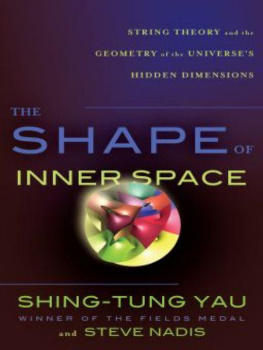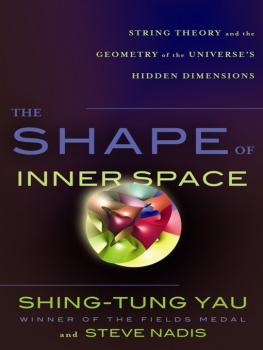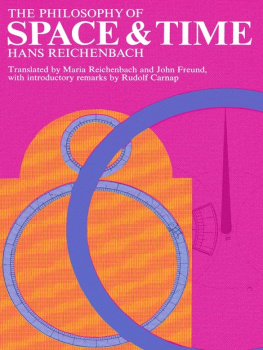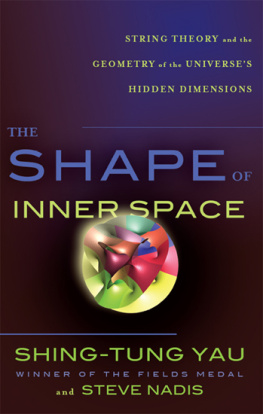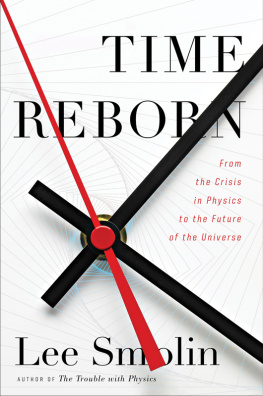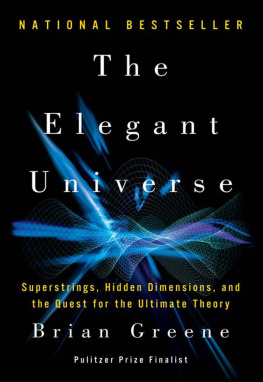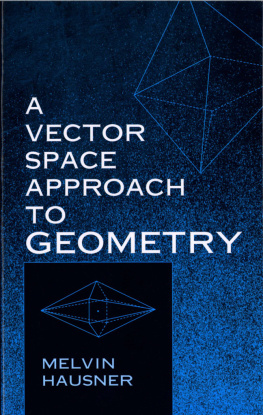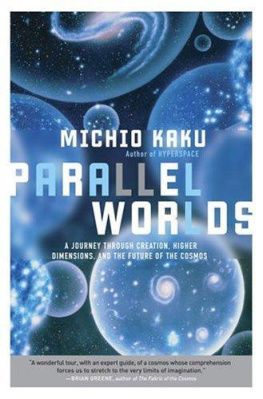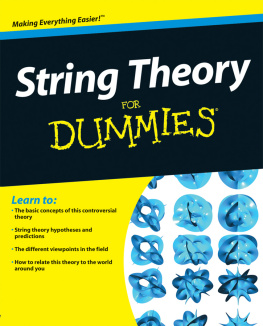Table of Contents
SPACE/TIME
Time, time
why does it vanish?
All manner of things
what infinite variety.
Three thousand rivers
all from one source.
Time, space
mind, matter, reciprocal.
Time, time
it never returns.
Space, space
how much can it hold?
In constant motion
always in flux.
Black holes lurking
mysteries afoot.
Space and time
one without bounds.
Infinite, infinite
the secrets of the universe.
Inexhaustible, lovely
in every detail.
Measure time, measure space
no one can do it.
Watched through a straw
whats to be learned has no end.
SHING-TUNG YAU
BEIJING, 2002
PREFACE
Mathematics is often called the language of science, or at least the language of the physical sciences, and that is certainly true: Our physical laws can only be stated precisely in terms of mathematical equations rather than through the written or spoken word. Yet regarding mathematics as merely a language doesnt do justice to the subject at all, as the word leaves the erroneous impression that, save for some minor tweaks here and there, the whole business has been pretty well sorted out.
In fact, nothing could be further from the truth. Although scholars have built a strong foundation over the course of hundredsand indeed thousandsof years, mathematics is still very much a thriving and dynamic enterprise. Rather than being a static body of knowledge (not to suggest that languages themselves are set in stone), mathematics is actually a dynamic, evolving science, with new insights and discoveries made every day rivaling those made in other branches of science, though mathematical discoveries dont capture the headlines in the same way that the discovery of a new elementary particle, a new planet, or a new cure for cancer does. In fact, save for the proof of a centuries-old problem from time to time, they rarely capture headlines at all.
Yet for those who appreciate the sheer force of mathematics, it can be viewed as not just a language but as the surest path to the truththe bedrock upon which the whole edifice of physical science rests. The strength of this discipline, again, lies not simply in its ability to explain physical reality or to reveal it, because to a mathematician, mathematics is reality. The geometric figures and spaces, whose existence we prove, are just as real to us as are the elementary particles of physics that make up all matter. But we consider mathematical structures even more fundamental than the particles of nature because mathematical structures can be used not only to understand such particles but also to understand the phenomena of everyday life, such as the contours of a human face or the symmetry of flowers. What excites geometers perhaps most of all is the power and beauty of the abstract principles that underlie the familiar forms and shapes of our contemporary world.
For me, the study of mathematics and my specialty, geometry, has truly been an adventure. I still recall the thrill I felt during my first year of graduate school, whenas a twenty-year-old fresh off the boat, so to speakI first learned about Einsteins theory of gravity. I was struck by the notion that gravity and curvature could be regarded as one and the same, as Id already become fascinated with curved surfaces during my undergraduate years in Hong Kong. Something about these shapes appealed to me on a visceral level. I dont know why, but I couldnt stop thinking about them. Hearing that curvature lay at the heart of Einsteins theory of general relativity gave me hope that someday, and in some way, I might be able to contribute to our understanding of the universe.
The Shape of Inner Space describes my explorations in the field of mathematics, focusing on one discovery in particular that has helped some scientists build models of the universe. No one can say for sure whether these models will ultimately prove correct. But the theory underlying these models, nevertheless, possesses a beauty that I find undeniable.
Taking on a book of this nature has been challenging, to say the least, for someone like me whos more comfortable with geometry and nonlinear differential equations than writing in the English language, which is not my native tongue. I find it frustrating because theres a great clarity, as well as a kind of elegance, in mathematical equations that is difficult, if not impossible, to express in words. Its a bit like trying to convey the majesty of Mount Everest or Niagara Falls without any pictures.
Fortunately, Ive gotten some well-needed help on this front. Although this narrative is told through my eyes and in my voice, my coauthor has been responsible for translating the abstract and abstruse mathematics into (hopefully) lucid prose.
When I proved the Calabi conjecturean effort that lies at the heart of this bookI dedicated the paper containing that proof to my late father, Chen Ying Chiu, an educator and philosopher who instilled in me a respect for the power of abstract thought. I dedicate this book to him and to my late mother, Leung Yeuk Lam, both of whom had a profound influence on my intellectual growth. In addition, I want to pay tribute to my wife, Yu-Yun, who has been so tolerant of my rather excessive (and perhaps obsessive) research and travel schedule, and to my sons, Isaac and Michael, of whom Im very proud.
I also dedicate this book to Eugenio Calabi, the author of the aforementioned conjecture, whom Ive known for nearly forty years. Calabi were an enormously original mathematician with whom Ive been linked for more than a quarter century through a class of geometric objects, Calabi-Yau manifolds, which serve as the principal subject of this book. The term Calabi-Yau has been so widely used since it was coined in 1984 that I almost feel as if Calabi is my first name. And if it is to be my first nameat least in the publics mindits one Im proud to have.
The work that I do, much of which takes place along the borders between mathematics and theoretical physics, is rarely done in isolation, and I have benefited greatly from interactions with friends and colleagues. Ill mention a few people, among many, who have collaborated with me directly or inspired me in various ways.
First, Id like to pay tribute to my teachers and mentors, a long line of illustrious people that includes S. S. Chern, Charles Morrey, Blaine Lawson, Isadore Singer, Louis Nirenberg, and the aforementioned Calabi. Im pleased that Singer invited Robert Geroch to speak at a 1973 Stanford conference, where Geroch inspired my work with Richard Schoen on the positive mass conjecture. My subsequent interest in physics-related mathematics has always been encouraged by Singer.
Im grateful for the conversations I had on general relativity while visiting Stephen Hawking and Gary Gibbons at Cambridge University. I learned about quantum field theory from one of the masters of the subject, David Gross. I remember in 1981, when I was a professor at the Institute for Advanced Study, the time Freeman Dyson brought a fellow physicist, who had just arrived in Princeton, into my office. The newcomer, Edward Witten, told me about his soon-to-be-published proof of the positive mass conjecturea conjecture I had previously proved with a colleague using a very different technique. I was struck, for the first of many times to come, by the sheer force of Wittens mathematics.
Over the years, Ive enjoyed close collaborations with a number of people, including Schoen (mentioned above), S. Y. Cheng, Richard Hamilton, Peter Li, Bill Meeks, Leon Simon, and Karen Uhlenbeck. Other friends and colleagues who have added to this adventure in many ways include Simon Donaldson, Robert Greene, Robert Osserman, Duong Hong Phong, and Hung-Hsi Wu.


